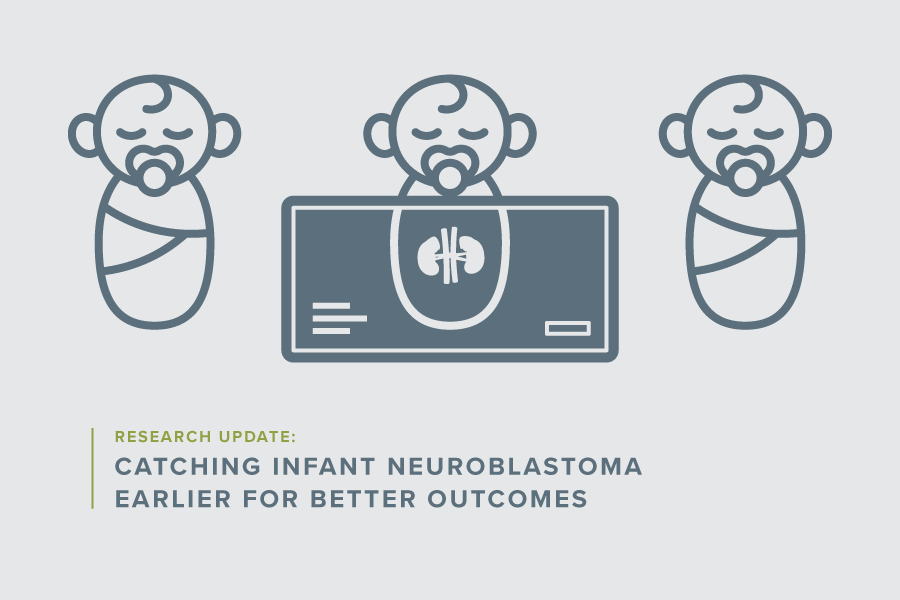Even before a baby is born, neuroblastoma can start to quietly creep through their nerve cells, growing into a tumor that might go undetected for months or even years. Infants and young children whose disease is classified as high-risk — where the cancer has spread and cannot be surgically removed — face some of the worst survival rates of childhood cancers.
But what if a simple heel prick soon after birth could catch neuroblastoma earlier and change a child’s cancer trajectory? That’s what Eun Mi Jung, PhD, an epidemiologist and post-doctoral associate in the University of Minnesota Department of Pediatrics, hopes to find out. With support from an Emerging Scientist Award from Children’s Cancer Research Fund (CCRF), Jung is investigating whether it makes sense to revive newborn screening for neuroblastoma using newborn dried blood spots coupled with genetic information.
“I’m very excited to do this research,” she said. “The survival rate of patients with high-risk neuroblastoma with intensive treatments, including surgery, chemotherapy, immunotherapy and radiation, is only 40 to 50 percent. Our hope is that if we can detect high-risk neuroblastoma patients at early onset of disease, we can improve survival rates.”
Canada, Japan and Germany previously screened infants for neuroblastoma, but the practice was stopped because it didn’t lead to a reduction in mortality rates and because of concerns about overdiagnosis of cases with favorable outcomes resulting in unnecessary additional testing, treatment of the child, and psychological and financial burdens for the families. However, Jung believes a new and improved screening process could lead to better results for the children most at risk of adverse outcomes.
Children with neuroblastoma have high levels of chemicals called catecholamine metabolites in their urine and blood. The previous screening process used a chemical analysis to look for catecholamine metabolites in urine. Newborn dried blood spots are a viable alternative to urine samples because they are readily available in the United States, are easier to store and are less affected by storage conditions. Jung also proposes adding another step: screening those who test positive for catecholamine metabolites for specific genetic variants that are associated with high-risk neuroblastoma.
“Neuroblastoma is the most common cancer in infants, but there are few studies that have examined the causes of this disease,” she said. “We think incorporation of newborn dried blood spot screening for catecholamine metabolites along with genetic analysis is really important because if we can identify high-risk neuroblastoma patients earlier, it could lead to faster treatment for patients and better outcomes.”
For her initial two-year study, Jung plans to test her hypothesis using newborn dried blood spots from the Michigan Neonatal Biobank. “This research is still in the pilot stage so we’re still exploring our options about how to improve the screening for neuroblastoma,” she said. “In the future, I would like to expand the study to other states so that I may confirm my results in a wider study sample. And then if my research findings are valid, we can suggest the revival of neuroblastoma screening at the national level so we can identify high-risk neuroblastoma patients, reduce treatment risks and improve survival outcomes.”
While initially focused on neuroblastoma, Jung looks forward to studying other childhood cancers as she develops her independent research career. During her graduate studies in epidemiology and public health, she focused on understanding the association between exposure to environmental hazards and children’s health. That sparked her interest in the genetic determinants of childhood cancer, which led her to a post-doctoral fellowship working with Professor Logan Spector, PhD, at the University of Minnesota.
“I’m learning so much about pediatric cancer and the genetics related to it,” she said. “And as I learn more, I’m seeing a more critical need for understanding the factors that drive childhood cancer.”
She wouldn’t be able to pursue her own research without CCRF’s support, she noted.
“It’s difficult to secure research funding because pediatric cancer is rare and there are limited funding opportunities,” she said. “CCRF’s philanthropy is really meaningful for pediatric cancer researchers like me, and I am truly grateful to this organization.”
Your donation supports Emerging Scientists
By donating to Children’s Cancer Research Fund, you’re giving emerging scientists the support they need to put their great ideas into practice. Learn more about CCRF's commitment to funding researchers early in their careers.




